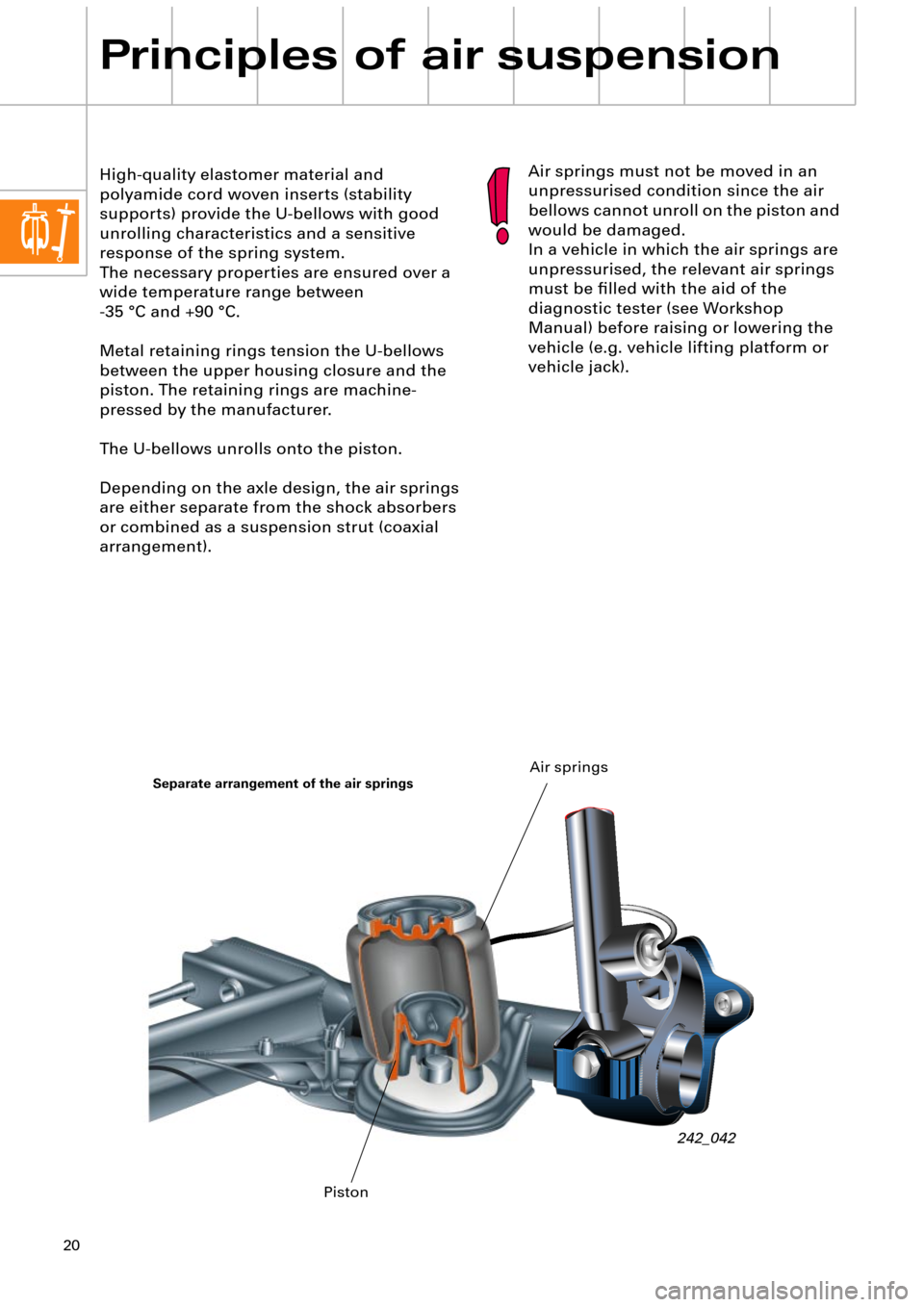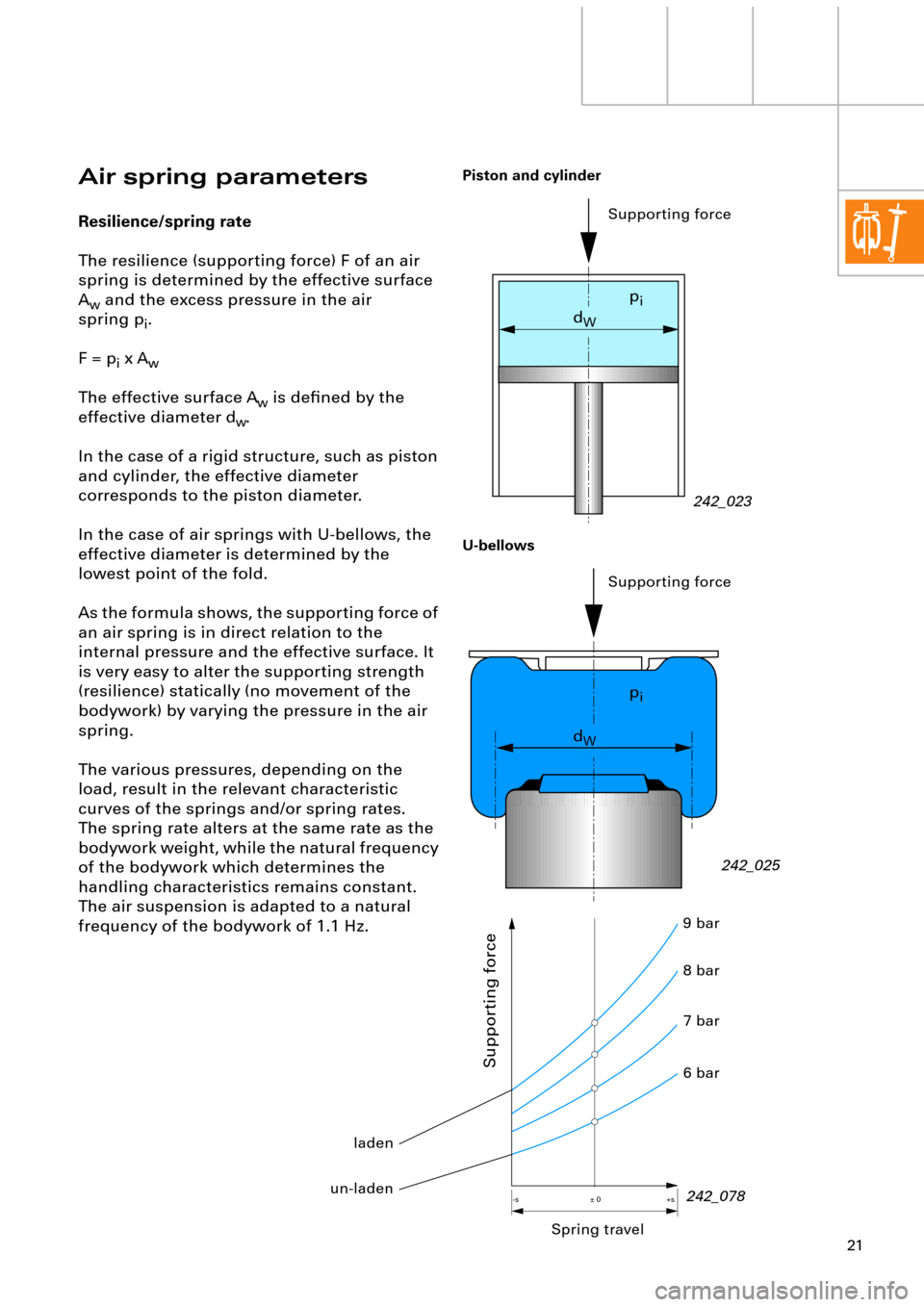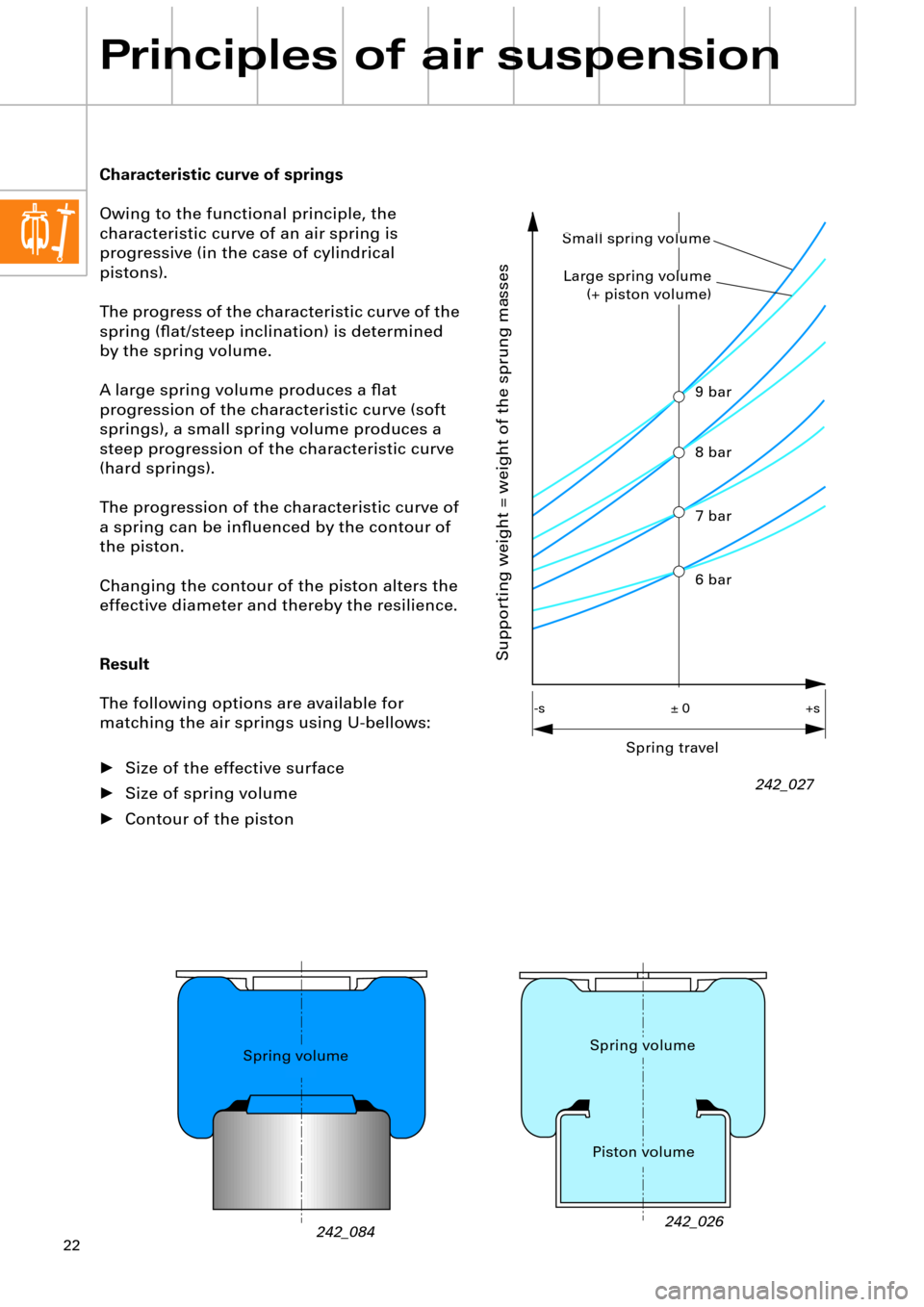Page 20 of 64

20
Principles of air suspension
High-quality elastomer material and
polyamide cord woven inserts (stability
supports) provide the U-bellows with good
unrolling characteristics and a sensitive
response of the spring system.
The necessary properties are ensured over a
wide temperature range between
-35 ¡C and +90 ¡C.
Metal retaining rings tension the U-bellows
between the upper housing closure and the
piston. The retaining rings are machine-
pressed by the manufacturer.
The U-bellows unrolls onto the piston.
Depending on the axle design, the air springs
are either separate from the shock absorbers
or combined as a suspension strut (coaxial
arrangement).Air springs must not be moved in an
unpressurised condition since the air
bellows cannot unroll on the piston and
would be damaged.
In a vehicle in which the air springs are
unpressurised, the relevant air springs
must be Þlled with the aid of the
diagnostic tester (see Workshop
Manual) before raising or lowering the
vehicle (e.g. vehicle lifting platform or
vehicle jack).
242_042
Separate arrangement of the air springs
PistonAir springs
Page 21 of 64

21
-s +s± 0
Air spring parameters
Resilience/spring rate
The resilience (supporting force) F of an air
spring is determined by the effective surface
A
w and the excess pressure in the air
spring p
i.
F = p
i x Aw
The effective surface Aw is deÞned by the
effective diameter d
w.
In the case of a rigid structure, such as piston
and cylinder, the effective diameter
corresponds to the piston diameter.
In the case of air springs with U-bellows, the
effective diameter is determined by the
lowest point of the fold.
As the formula shows, the supporting force of
an air spring is in direct relation to the
internal pressure and the effective surface. It
is very easy to alter the supporting strength
(resilience) statically (no movement of the
bodywork) by varying the pressure in the air
spring.
The various pressures, depending on the
load, result in the relevant characteristic
curves of the springs and/or spring rates.
The spring rate alters at the same rate as the
bodywork weight, while the natural frequency
of the bodywork which determines the
handling characteristics remains constant.
The air suspension is adapted to a natural
frequency of the bodywork of 1.1 Hz.
242_023
242_025 Supporting force
dW
Supporting force
dW
Piston and cylinder
U-bellows
Spring travel
Supporting force
242_078 6 bar 7 bar 8 bar 9 bar
pi
pi
laden
un-laden
Page 22 of 64

22
-s+s 0
Characteristic curve of springs
Owing to the functional principle, the
characteristic curve of an air spring is
progressive (in the case of cylindrical
pistons).
The progress of the characteristic curve of the
spring (ßat/steep inclination) is determined
by the spring volume.
A large spring volume produces a ßat
progression of the characteristic curve (soft
springs), a small spring volume produces a
steep progression of the characteristic curve
(hard springs).
The progression of the characteristic curve of
a spring can be inßuenced by the contour of
the piston.
Changing the contour of the piston alters the
effective diameter and thereby the resilience.
Result
The following options are available for
matching the air springs using U-bellows:
¥ Size of the effective surface
¥ Size of spring volume
¥ Contour of the piston
Principles of air suspension
242_026242_027
Spring volume
Piston volume
Small spring volume
Large spring volume
(+ piston volume)
Spring travel
Supporting weight = weight of the sprung masses
6 bar 7 bar
8 bar 9 bar
242_084 Spring volume
Page 24 of 64
24
Principles of air suspension
As previously mentioned, vibration damping
has a fundamental effect on driving safety
and comfort.
However, the requirements of driving safety
(driving dynamics) and driving comfort are
conßicting.
Within certain limits, the following applies in
principle:
¥ A higher rate of damping improves driving
dynamics and reduces driving comfort.
¥ A lower rate of damping lessens driving
dynamics and improves driving comfort.The term Òshock absorbersÓ is
misleading as it does not precisely
describe the function.
For this reason we shall use the term
Òvibration damperÓ instead.
242_022 Damped vibration
Un-damped vibrationUneven groundDirection of
travel Sprung mass
Unsprung mass
Page 26 of 64
26
Principles of air suspension
During rebound, the piston valve alone
carries out the damping action and exerts a
predetermined resistance against the oil
ßowing downwards.
The oil required in the working chamber can
ßow back unhindered via the non-return valve
in the bottom valve. Function
During compression, damping is determined
by the bottom valve and to a certain extent by
the return ßow resistance of the piston.
The oil displaced by the piston rod ßows into
the oil reservoir. The bottom valve exerts a
deÞned resistance against this ßow, thereby
braking the movement.
242_081
Rebound Compression
Bottom valve
Oil reservoir
Piston valve
Damper valve
Non-return valve
Page 28 of 64
28
Principles of air suspension
During rebound, oil is forced out of the upper
chamber through the suction valve integrated
into the piston which exerts a deÞned
resistance against the oil. The gas cushion
thereby expands by the amount of the
emerging piston rod volume. Function
During compression, oil is forced out of the
lower chamber through the discharge valve
integrated into the piston which exerts a
deÞned resistance against the oil. The gas
cushion thereby compresses by the amount
of the piston rod volume inserted.
242_083
Rebound Compression
Gas cushion
Reboundvalve
Compression
valve
Gas cushion
Damper valves
Page 29 of 64
29
0,13 0 0 200 400 600 800 1000
1200 1400 1600
0,26
0,390,520,650,78 0,91 1,04
Advantage of this matching:
Good response of the vehicle suspension
ensures greater driving comfort.
The disadvantage of this matching occurs in
the case of a quick succession of irregularities
in the road. If the time between the individual
impacts is no longer sufÞcient for rebound,
the suspension can ÒhardenÓ signiÞcantly in
extreme cases, impairing driver comfort and
driver safety. Damping matching
We can basically distinguish between
compression and rebound in the damping
process.
The damping force during compression is
generally smaller than during rebound.
Consequently, irregularities in the road are
transmitted to the vehicle bodywork with
diminished force. The spring absorbs the
energy which is quickly dissipated during
rebound by the more efÞcient action of the
shock absorber.
242_084
Piston speed in m/s
Damping force in N
Compression Rebound
Page 30 of 64
30
Principles of air suspension
The degree of damping
... (the factor which determines how quickly
the vibrations are eliminated)
of the vehicle body is dependant on the
damping force of the shock absorber and the
sprung masses.
If the damping force is unchanged, the
following applies:
An increase of the sprung masses reduces the
degree of damping. This means that the
vibrations are eliminated more slowly.
A reduction of the sprung masses increases
the degree of damping. This means that the
vibrations are eliminated more rapidly.The degree of damping describes how
much kinetic energy a vibration system
been dissipated between two vibration
cycles as a result of damping.
The damping coefÞcient is just another
term for degree of damping.
242_068
Increased sprung mass
Reduced sprung mass
Spring travel Spring travel
Low degree of damping
Higher degree of damping